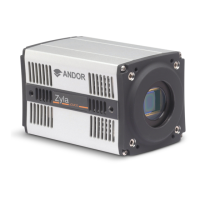version 2.0 rev 18 Feb 2021
22
2.3 Understanding Read Noise in sCMOS
sCMOStechnologyboastsanultra-lowreadnoiseoorthatsignicantlyexceedsthatofeventhebestCCDs,
and at several orders of magnitude faster pixel readout speeds. For those more accustomed to dealing with
CCDs, it is useful to gain an understanding of the nature of read noise distribution in CMOS imaging sensors.
CCD architecture is such that the charge from each pixel is transferred through a common readout structure, at
leastinsingleoutputportCCDs,wherechargeisconvertedtovoltageandampliedpriortodigitizationinthe
Analog to Digital Converter (ADC) of the camera. This results in each pixel being subject to the same readout
noise.However,CMOStechnologydiersinthateachindividualpixelpossessesitsownreadoutstructurefor
convertingchargetovoltage.InthesCMOSsensor,eachcolumnpossessesdualampliersandADCsatboth
top and bottom (facilitating the split sensor readout). During readout, voltage information from each pixel is fed
directlytotheappropriateamplier/ADC,arowofpixelsatatime(seeTechnicalNoteonRollingandGlobal
Shutter modes).
As a consequence of each pixel having its own individual readout structure, the overall readout noise in
CMOSsensorsisdescribedasadistribution,asexempliedinFigure 10 below, which is a representative
noisehistogramfromaZyla5.5cameraatthefastestreadoutspeedof560MHz(or280MHzx2halves).It
is standard to describe noise in CMOS technology by citing the median value of the distribution. In the data
presented, the median value is 1.38 electron RMS. This means that 50% of pixels have a noise less than 1.38
electrons, and 50% have noise greater than 1.38 electrons. While there will be a small percentage of pixels
with noise greater than 2 or 3 electrons, observable as the low level tail towards the higher noise side of the
histogram,itmustberememberedthataCCDInterlinecamerareadingoutat20MHzwouldhave100%ofits
pixels reading out with read noise typically ranging between 6 and 10 electrons RMS (depending on camera
design).
Figure10:RepresentativehistogramshowingreadnoisedistributionatfastestreadoutspeedofZyla5.5,560MHz(280MHzx2).
The median value of 1.38 e
-
means50%pixelshavereadnoiselessthan1.38e-and50%havegreaterthan1.38e-.Thelineat6e-
representsatypicalreadnoisevaluefromawelloptimizedInterlineCCD–allpixelsinaCCDessentiallysharethesamenoisevalue
Optimized Interline CCD
(at 20MHz readout rate)
Median = 1.38e
-

